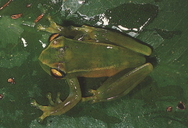|
Description
M 26-30 mm. Dorsally uniformly green with two rather distinct white or yellowish dorsolateral stripes that typically continue at least to the posterior third of the dorsum. Iris usually dark brown in its inner area and beige in its outer area. Iris periphery blue (Glaw and Vences 2007).
Distribution and Habitat
Country distribution from AmphibiaWeb's database: Madagascar
Ambatolahy forest, Andohahela, Vevembe (Glaw and Vences 2007). It occurs at elevations above 400 m asl (Nussbaum and Andreone 2008). It may occur up to 1000 m asl at Ranomafama, but this is based on a single specimen photograph only, of an animal at Ranomafama which may be this species (Nussbaum and Andreone 2008). Found in pristine rainforest (Nussbaum and Andreone 2008).Life History, Abundance, Activity, and Special Behaviors
Males emit their calls at night from perches 1-3 m above the ground in the vegetation along streams in rainforest. Calls consist of a series of fast and distinct trills, very similar to the call of B. jaegeri and different from other green Boophis species in south-eastern Madagascar, although it could be mistaken with the call of B. sp. aff. sibilans (Glaw and Vences 2007). This species is a stream-breeder (Nussbaum and Andreone 2008).
Trends and Threats
Abundant within its range, and may possibly occur more widely. It requires pristine forest and has not been found in degraded habitat. It occurs within a protected area, the Parc National d'Andohahela. If the range extends outside the Parc National d'Andohahela, that habitat is threatened by increasing subsistence agriculture, logging, charcoal manufacture, invasion and spread of eucalyptus, increased grazing, and expanding human settlement (Nussbaum and Andreone 2008).
Possible reasons for amphibian decline General habitat alteration and loss
Habitat modification from deforestation, or logging related activities
Intensified agriculture or grazing
Subtle changes to necessary specialized habitat
Comments
Partly taken from Glaw and Vences (2007), with permission.
References
Glaw, F., and Vences, M. (2007). Field Guide to the Amphibians and Reptiles of Madagascar. Third Edition. Vences and Glaw Verlag, Köln.
Nussbaum, R., and Andreone, F. (2008). Boophis andohahela. In: IUCN 2008. 2008 IUCN Red List of Threatened Species. www.iucnredlist.org. Downloaded on 23 March 2009.
Originally submitted by: Miguel Vences and Frank Glaw (first posted 2009-03-17)
Edited by: Kellie Whittaker (2010-07-19)Species Account Citation: AmphibiaWeb 2010 Boophis andohahela <https://amphibiaweb.org/species/4330> University of California, Berkeley, CA, USA. Accessed May 22, 2025.
Feedback or comments about this page.
Citation: AmphibiaWeb. 2025. <https://amphibiaweb.org> University of California, Berkeley, CA, USA. Accessed 22 May 2025.
AmphibiaWeb's policy on data use.
|
